1998 CHEVROLET CAVALIER belt
[x] Cancel search: beltPage 220 of 400
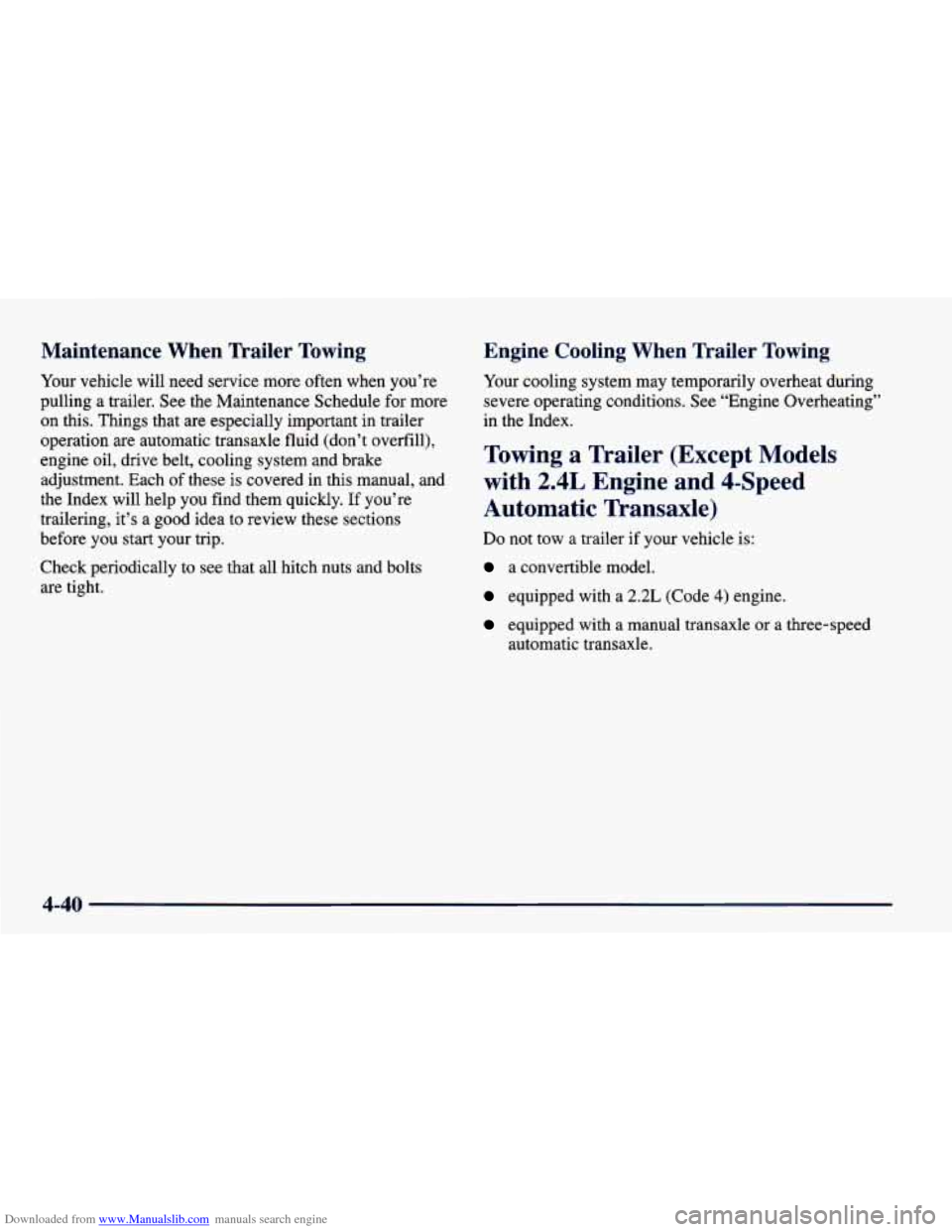
Downloaded from www.Manualslib.com manuals search engine Maintenance When Trailer Towing
Your vehicle will need service more often when you’re
pulling a trailer. See the Maintenance Schedule for more
on this. Things that
are especially important in trailer
operation are automatic transaxle fluid (don’t overfill), engine oil, drive belt, cooling system and brake
adjustment. Each of these
is covered in this manual, and
the Index will help you find them quickly. If you’re
trailering, it’s a good idea to review these sections before you start your trip.
Check periodically
to see that all hitch nuts and bolts
are tight.
Engine Cooling When Trailer Towing
Your cooling system may temporarily overheat during
severe operating conditions. See “Engine Overheating”
in the Index.
Towing a Trailer (Except Models
with
2.4L Engine and 4-Speed
Automatic Transaxle)
Do not tow a trailer if your vehicle is:
a convertible model.
equipped with a 2.2L (Code 4) engine.
equipped with a manual transaxle or a three-speed
automatic transaxle.
4-40
Page 259 of 400
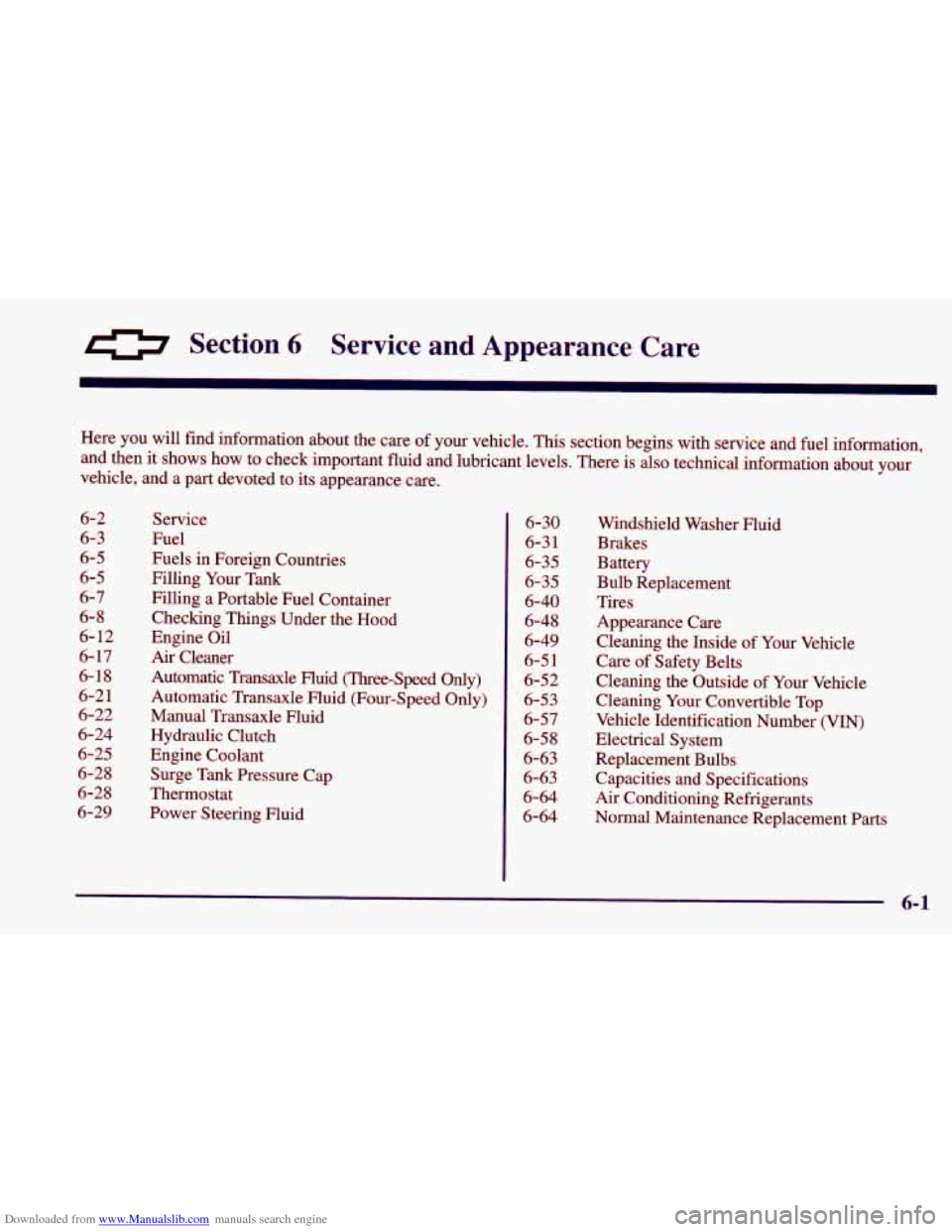
Downloaded from www.Manualslib.com manuals search engine 0 Section 6 Service and Appearance Care
I
Here you will find information about the care of your vehicle. This section begins with service and fuel informa\
tion,
and then it shows how to check important fluid and lubricant levels. There is also technical information about your
vehicle, and a part devoted to its appearance care.
6-2
6-3
6-5
6-5
6-7
6- 8
6- 12
6- 17
6-18
6-2
1
6-22
6-24
6-25
6-28
6-28
6-29
Service
Fuel
Fuels in Foreign Countries
Filling Your
Tank
Filling a Portable Fuel Container
Checking Things Under the Hood
Engine Oil
Air Cleaner
Automatic Transaxle Fluid (Three-Speed
Only)
Automatic Transaxle Fluid (Four-Speed Only)
Manual Transaxle Fluid
Hydraulic Clutch
Engine Coolant Surge Tank Pressure Cap
Thermostat
Power Steering Fluid
6-30
6-3
1
6-35
6-35
6-40
6-48
6-49
6-5
1
6-52
6-53
6-57
6-58
6-63
6-63
6-64
6-64
Windshield Washer Fluid
Brakes
Battery
Bulb Replacement
Tires
Appearance Care
Cleaning the Inside of
Your Vehicle
Care
of Safety Belts
Cleaning the Outside
of Your Vehicle
Cleaning Your Convertible Top
Vehicle Identification Number
(VIN)
Electrical System
Replacement Bulbs
Capacities and Specifications
Air Conditioning Refrigerants
Normal Maintenance Replacement Parts
6-1
Page 302 of 400
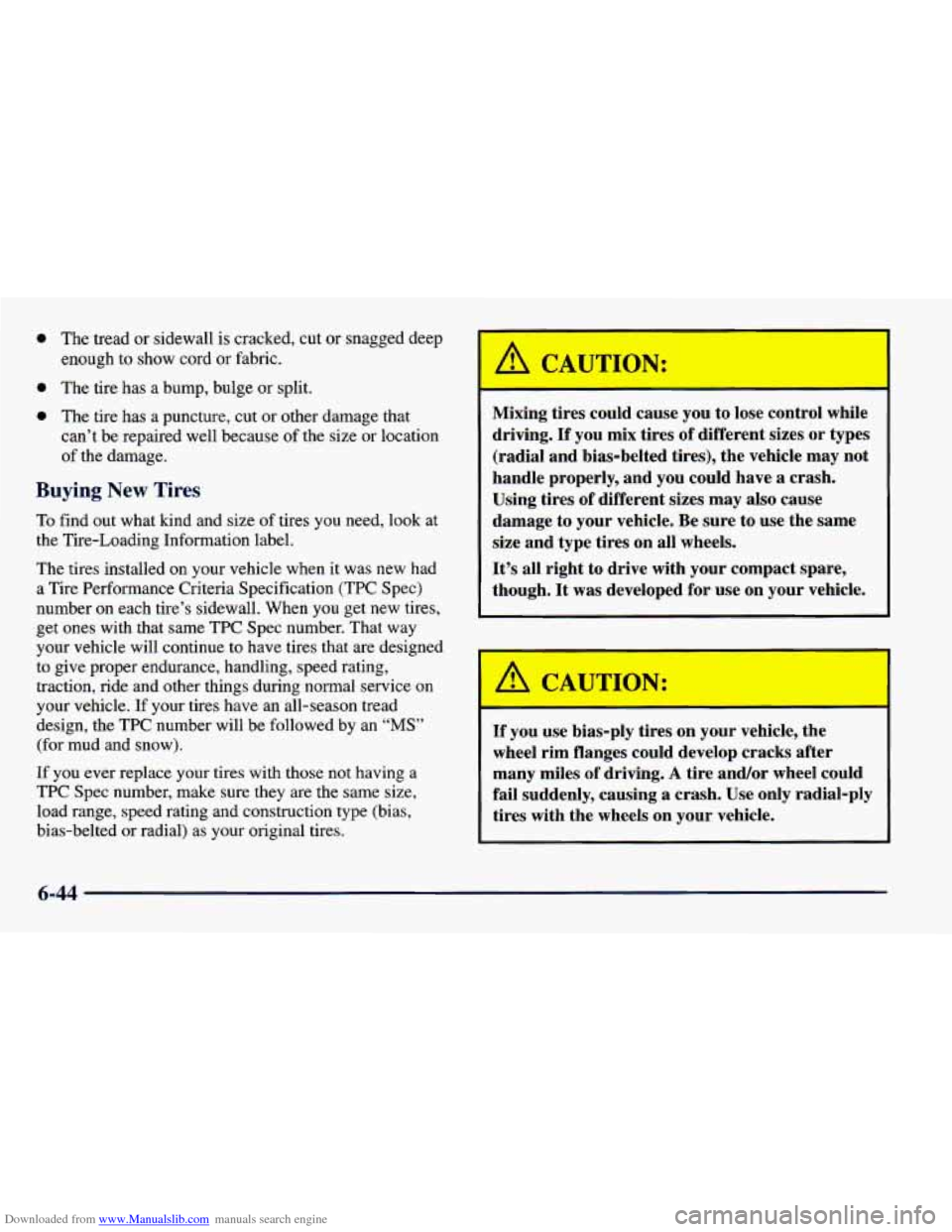
Downloaded from www.Manualslib.com manuals search engine 0 The tread or sidewall is cracked, cut or snagged deep
enough to
show cord or fabric.
0 The tire has a bump, bulge or split.
0 The tire has a puncture, cut or other damage that
can’t be repaired well because of the size or location
of the damage.
Buying New Tires
To find out what kind and size of tires you need, look at
the Tire-Loading Information label.
The tires installed on your vehicle when it was new had
a Tire Performance Criteria Specification (TPC Spec)
number on each tire’s sidewall. When you get new tires,
get ones with that same
TPC Spec number. That way
your vehicle will continue to have tires that are designed
to give proper endurance, handling, speed rating,
traction, ride and other things during normal service on your vehicle. If your tires have an all-season tread
design, the TPC number will be followed by an
“MS”
(for mud and snow).
If you ever replace your tires with those not having a
TPC Spec number, make sure they are the same size,
load range, speed rating and construction type (bias,
bias-belted or radial) as your original tires.
Mixing tires could cause you to lose control while
driving.
If you mix tires of different sizes or types
(radial and bias-belted tires), the vehicle may not
handle properly, and you could have
a crash.
Using tires of different sizes may also cause
damage to your vehicle. Be sure to use the same
size and type tires on all wheels.
It’s all right to drive with your compact spare,
though. It was developed for use on your vehicle.
If you use bias-ply tires on your vehicle, the
wheel rim flanges could develop cracks after
many miles
of driving. A tire and/or wheel could
fail suddenly, causing a crash. Use only radial-ply
tires with the wheels on your vehicle.
1
6-44
Page 309 of 400
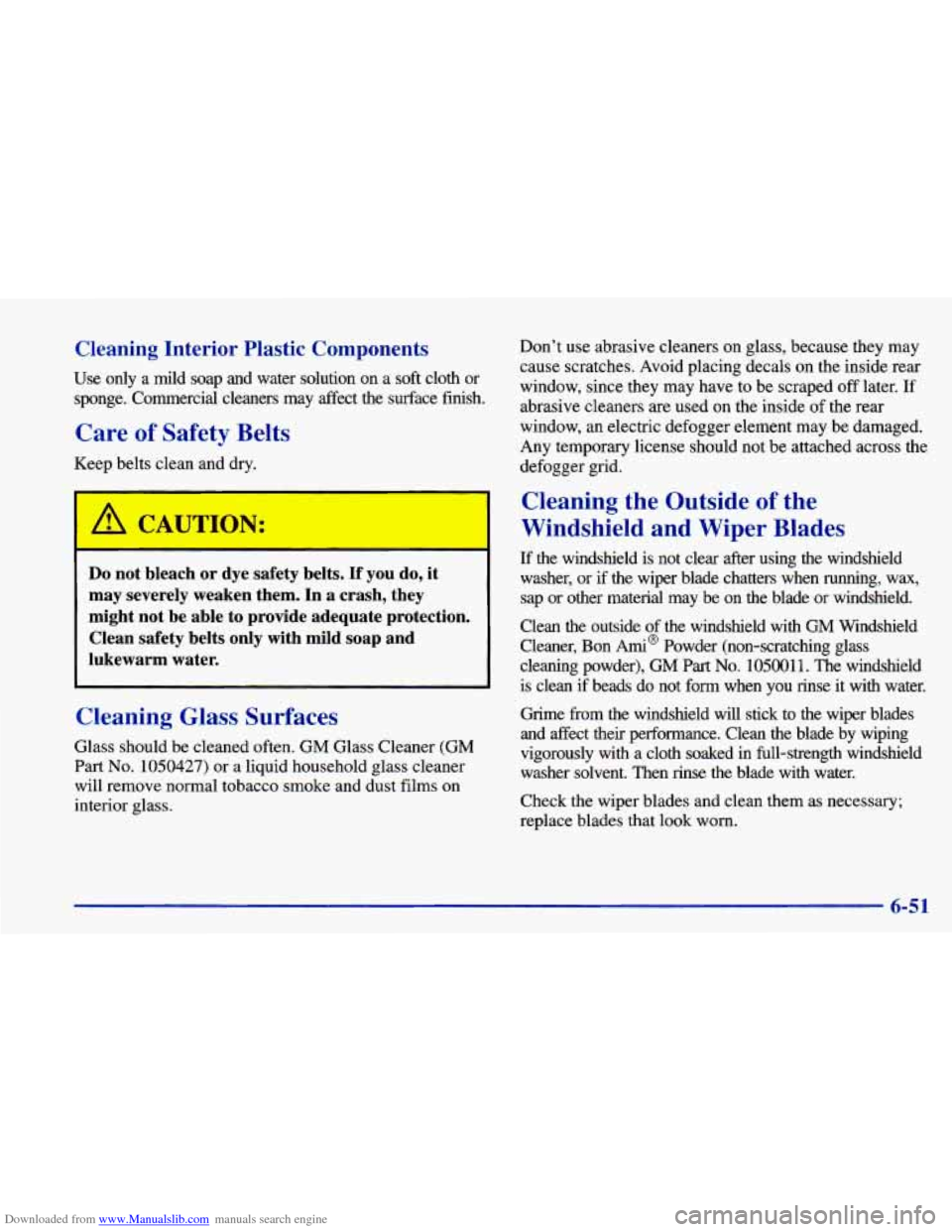
Downloaded from www.Manualslib.com manuals search engine Cleaning Interior Plastic Components
Use only a mild soap and water solution on a soft cloth or
sponge. Commercial cleaners may affect the surface finish.
Care of Safety Belts
Keep belts clean and dry.
Do not bleach or dye safety belts. If you do, it
may severely weaken them. In a crash, they
might not be able to provide adequate protection. Clean safety belts only with mild soap and
lukewarm water.
I I
Cleaning Glass Surfaces
Glass should be cleaned often. GM Glass Cleaner (GM
Part
No. 1050427) or a liquid household glass cleaner
will remove normal tobacco smoke and dust films on
interior glass. Don’t use abrasive cleaners on glass, because they
may
cause scratches. Avoid placing decals on the inside rear
window, since they may have to be scraped off later.
If
abrasive cleaners are used on the inside of the rear
window, an electric defogger element may be damaged.
Any temporary license should not be attached across the defogger grid.
Cleaning the Outside of the
Windshield and Wiper Blades
If the windshield is not clear after using the windshield
washer, or if the wiper blade chatters when running, wax,
sap or other material may be on the blade
or windshield.
Clean the outside of the windshield with GM Windshield Cleaner, Bon
Ami@ Powder (non-scratching glass
cleaning powder), GM
Part No. 105001 1. The windshield
is clean if beads do not form when you rinse it with water.
Grime from the windshield will stick
to the wiper blades
and affect their performance. Clean the blade by wiping
vigorously with a cloth soaked in hll-strength windshield
washer solvent. Then rinse the blade with water.
Check the wiper blades and clean them as necessary;
replace blades that look worn.
6-51
Page 331 of 400
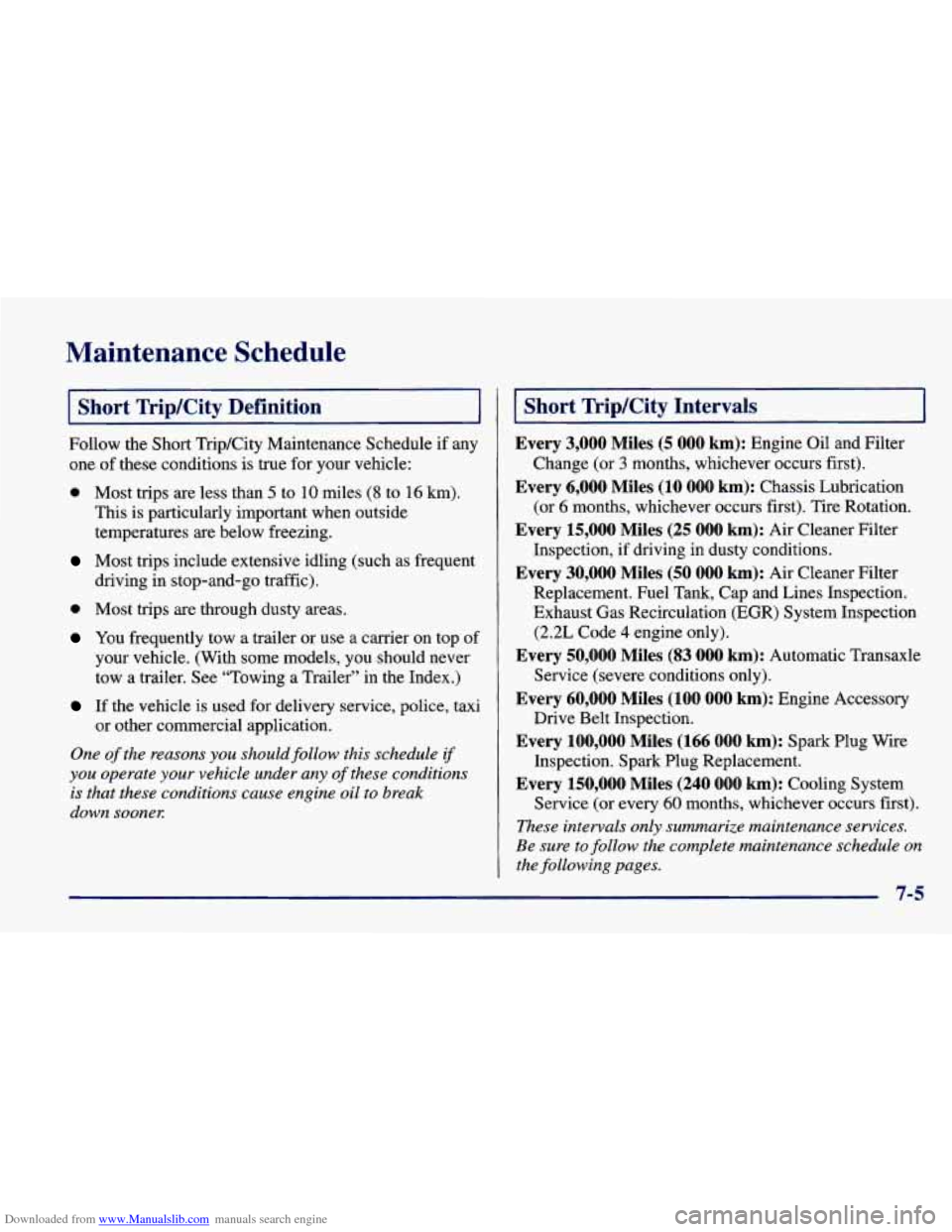
Downloaded from www.Manualslib.com manuals search engine Maintenance Schedule
-G/City Definition
Follow the Short TripKity Maintenance Schedule if any
one of these conditions is true for your vehicle:
0 Most trips are less than 5 to 10 miles (8 to 16 km).
This is particularly important when outside
temperatures are below freezing.
driving in stop-and-go traffic).
Most trips include extensive idling (such as frequent
0 Most trips are through dusty areas.
You frequently tow a trailer or use a carrier on top of
your vehicle. (With some models, you should never
tow a trailer. See “Towing a Trailer” in the Index.)
If the vehicle is used for delivery service, police, taxi
One of the reasons you should follow this schedule if
you operate your vehicle under any of these conditions
is that these conditions cause engine oil to break
down soonex
or other commercial application.
Short Trip/City Intervals
Every 3,000 Miles (5 000 km): Engine Oil and Filter
Every 6,000 Miles (10 000 km): Chassis Lubrication
Every 15,000 Miles (25 000 km): Air Cleaner Filter
Every 30,000 Miles (50 000 km): Air Cleaner Filter
Change (or
3 months, whichever occurs first).
(or
6 months, whichever occurs first). Tire Rotation.
Inspection, if driving in dusty conditions.
Replacement. Fuel Tank, Cap and Lines Inspection. Exhaust Gas Recirculation (EGR) System Inspection (2.2L Code
4 engine only).
Every 50,000 Miles (83 000 km): Automatic Transaxle
Service (severe conditions only).
Every 60,000 Miles (100 000 km): Engine Accessory
Drive Belt Inspection.
Every 100,000 Miles (166 000 km): Spark Plug Wire
Inspection. Spark Plug Replacement.
Every 150,000 Miles (240 000 km): Cooling System
Service (or every
60 months, whichever occurs first).
These intervals only summarize maintenance services.
Be sure to follow the complete maintenance schedule
on
the following pages.
7-5
Page 332 of 400
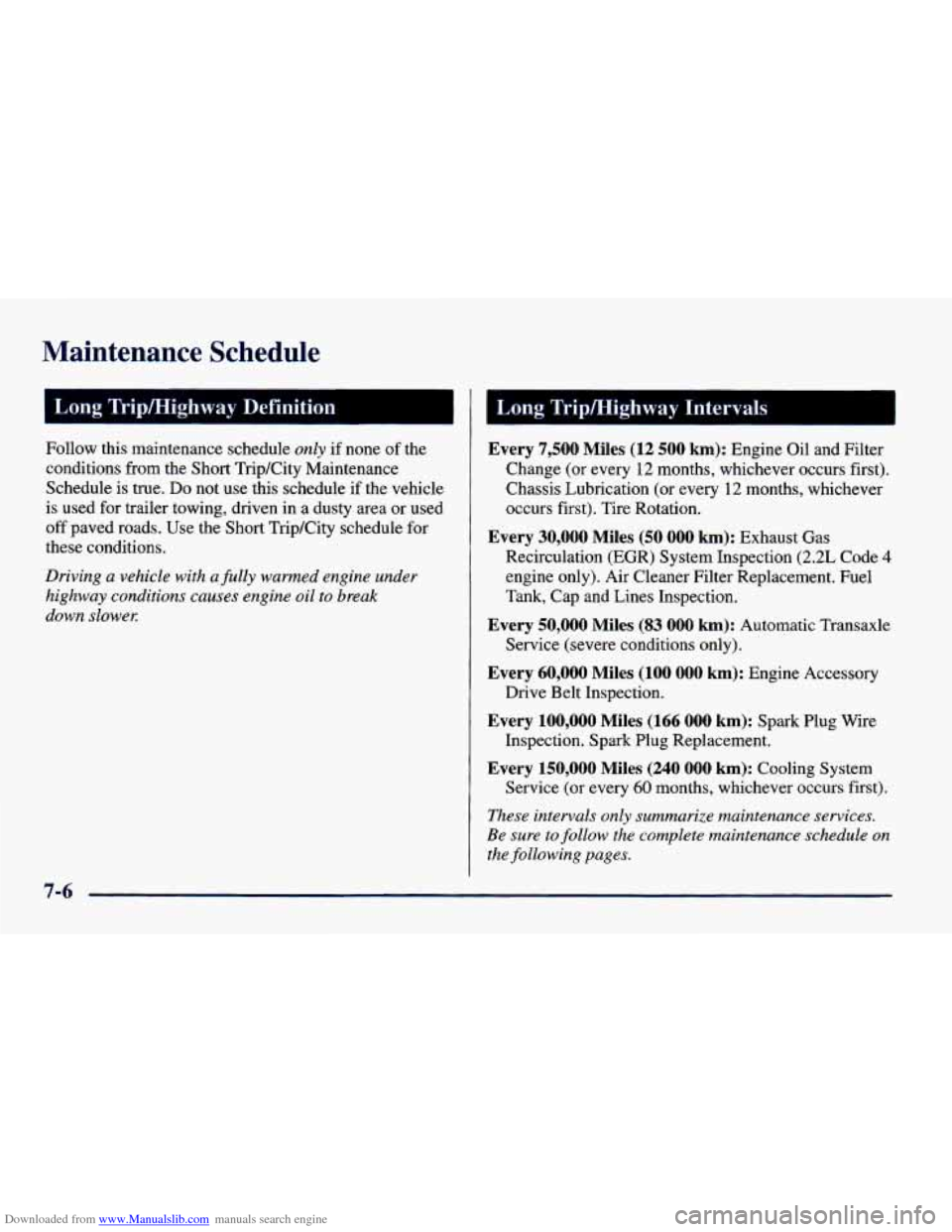
Downloaded from www.Manualslib.com manuals search engine Maintenance Schedule
1 Long Trip/Highway Definition
Follow this maintenance schedule only if none of the
conditions from the Short TripKity Maintenance
Schedule is
true. Do not use this schedule if the vehicle
is used for trailer towing, driven in a dusty area or used
off paved roads. Use the Short TripKity schedule for
these conditions.
Driving a vehicle with a fully warmed engine under
highway conditions causes engine oil to break
down slowel:
7-6
Long Trip/Highway Intervals - -
Every 7,500 Miles (12 500 km): Engine Oil and Filter
Change
(or every 12 months, whichever occurs first).
Chassis Lubrication (or every
12 months, whichever
occurs first). Tire Rotation.
Every 30,000 Miles (50 000 km): Exhaust Gas
Recirculation (EGR) System Inspection
(2.2L Code 4
engine only). Air Cleaner Filter Replacement. Fuel
Tank, Cap and Lines Inspection.
Every 50,000 Miles (83 000 km): Automatic Transaxle
Service (severe conditions only).
Every 60,000 Miles (100 000 km): Engine Accessory
Drive Belt Inspection.
Every 100,000 Miles (166 000 km): Spark Plug Wire
Inspection. Spark Plug Replacement.
Every 150,000 Miles (240 000 km): Cooling System
These intervals only summarize maintenance services.
Be sure to follow the complete maintenance schedule
on
the following pages.
Service (or every 60 months, whichever occurs first).
Page 340 of 400

Downloaded from www.Manualslib.com manuals search engine I Short Trip/City Maintenance Schedule I
54,000 Miles (90 000 km)
0 Change engine oil and filter (or every 3 months, whichever occurs first).
An Emission Control Service.
0 Lubricate chassis components (or every 6 months, whichever occurs first).
0 Rotate tires. See “Tire Inspection and Rotation” in the Index for proper
(See footnote
#.)
rotation pattern and additional information. (See footnote +.)
57,000 Miles (95 000 km)
17 Change engine
oil and filter (or every 3 months, whichever occurs first).
An Emission Control Service.
60,000 Miles (100 000 km)
0 Change engine oil and filter (or every 3 months, whichever occurs first).
0 Lubricate chassis components (or every 6 months, whichever occurs first).
0 Inspect engine accessory drive belt.
0 Replace air cleaner filter.
An Emission Control Service.
(See footnote #.)
An Emission Control Service.
An Emission Control Service.
DATE
MILEAGE
I I
I 1
7-14
Page 352 of 400
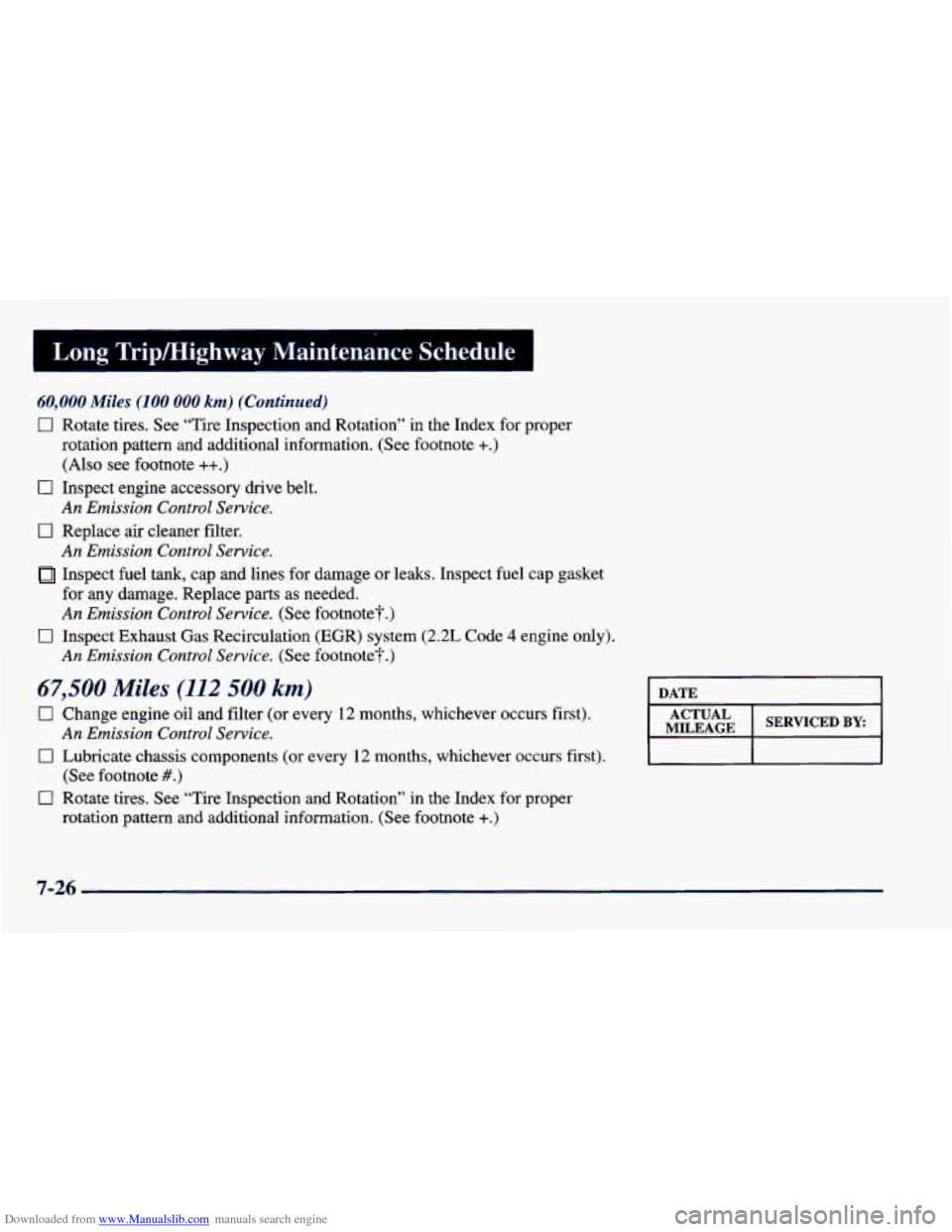
Downloaded from www.Manualslib.com manuals search engine Long Tripmighway Maintenance Schedule
60,000 Miles (100 000 km) (Continued)
0 Rotate tires. See “Tire Inspection and Rotation” in the Index for proper
rotation pattern and additional information. (See footnote
+.)
(Also see footnote ++.)
An Emission Control Service.
An Emission Control Service.
for any damage. Replace parts as needed.
An Emission Control Service. (See footnote?.)
An Emission Control Service. (See footnote?.)
0 Inspect engine accessory drive belt.
0 Replace air cleaner filter.
Inspect fuel tank, cap and lines for damage or leaks. Inspect fuel cap gasket
0 Inspect Exhaust Gas Recirculation (EGR) system (2.2L Code 4 engine only).
67,500 Miles (112 500 km)
0 Change engine oil and filter (or every 12 months, whichever occurs first).
0 Lubricate chassis components (or every 12 months, whichever occurs first).
0 Rotate tires. See “Tire Inspection and Rotation” in the Index for proper
An Emission Control Service.
(See footnote #.)
rotation pattern and additional information. (See footnote +.)
DATE
7-26